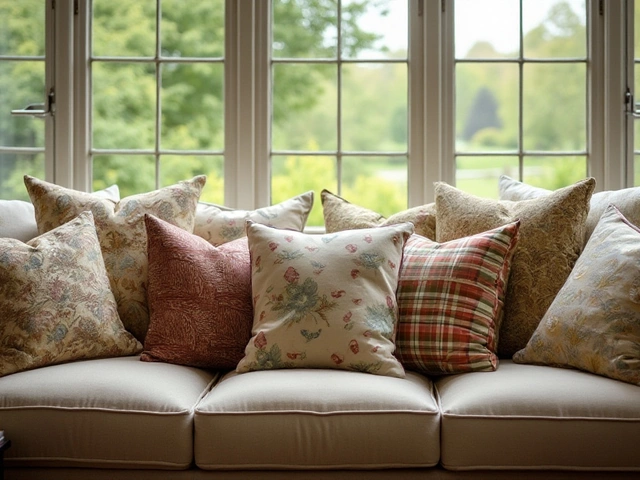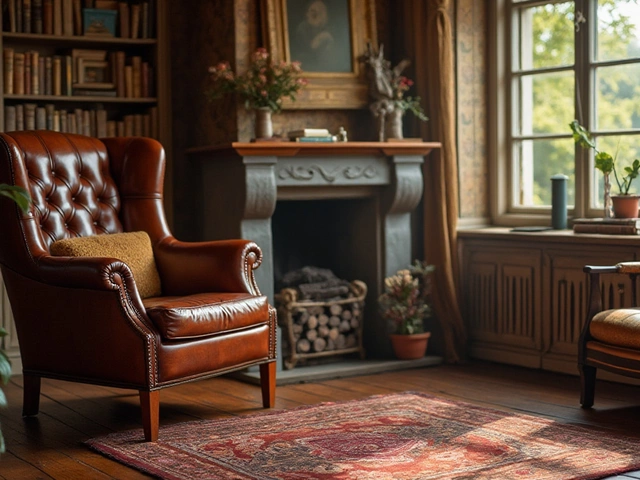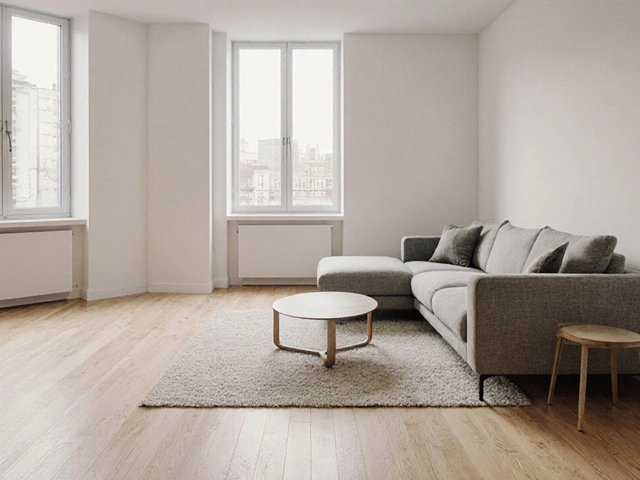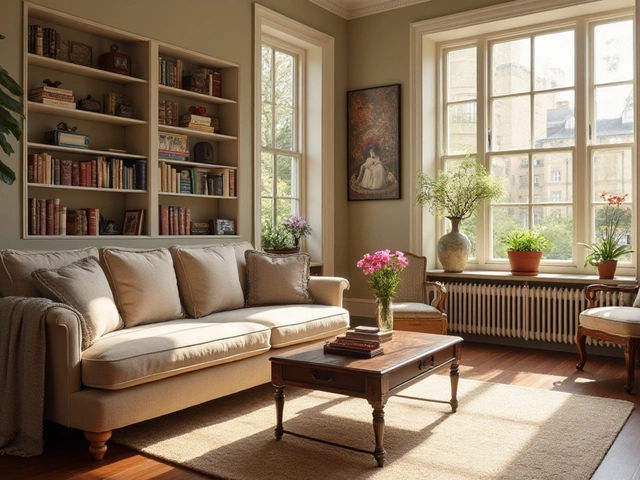 17
Jan,2025
17
Jan,2025
Buying furniture is a balancing act between style and budget. It's important to make smart financial decisions when it comes to home furnishings, as these decisions impact your living environment and your wallet for years. This exploration into the best ways to purchase furniture will guide you through different payment options and offer tips to make your buying experience as smooth as possible.
Whether you're moving into a new apartment or revamping your current space, the approach you take in purchasing furniture can influence your financial health. From paying cash to leveraging credit cards wisely, understanding how each method affects your budget will equip you for a more satisfying shopping experience. Let's delve into the strategies that can help you enjoy your new couch without unnecessary financial stress.
- Setting Your Furniture Budget
- Cash Payments: Simple and Effective
- Credit Card Purchases: Rewards and Risks
- Financing Plans: Breaking Down Big Costs
- Shopping Tips: Timing and Negotiation
- Assessing Quality vs. Cost
Setting Your Furniture Budget
Embarking on a journey to furnish your home can be exhilarating yet daunting, especially when you start contemplating the budgeting aspect. Setting a realistic budget is not just about attaching monetary values to future purchases; it's about aligning your financial capabilities with your lifestyle aspirations. For instance, consider starting with a comprehensive list of all pieces you envision for your home. Whether it's a plush sofa for the living room or a sturdy dining table centerpiece, every item should make its way onto this list.
Understanding your financial limits is crucial; without proper planning, it's easy to let alluring designs lead you astray. As a rule of thumb, aim to allocate no more than 20-30% of your available spending money each month towards furniture purchases. This way, your budget remains manageable without forsaking quality. Additionally, explore the idea of prioritizing. Do you need an entire set right away, or can you invest in key pieces and stagger purchases over time? Breaking it down might make the prospect less overwhelming.
Creating a furniture budget can also benefit from using technology. Several budget planning apps can help you categorize, track, and adjust your expenditures. These tools offer great insights into where you might be able to cut back, allowing you to foresee and address potential financial constraints in advance. Some apps even offer alerts about deals on items you've been eyeing, helping you snap up great buys without exceeding your financial plans.
An often-overlooked aspect of budgeting is factoring in delivery and assembly costs. Furniture buying tips frequently highlight these hidden costs, as they can easily tip the scales of your tight budget. Make it a point to ask about these additional fees upfront to prevent any unexpected surprises later on. Speaking of surprises, don't underestimate the power of seasonal sales. Wait for sales events such as Black Friday or end-of-season clearances to save significantly.
"Your home should tell the story of who you are, and be a collection of what you love," suggests interior designer Nate Berkus, encouraging one to prioritize personal tastes in furnishing choices.
It is essential to remember that high cost doesn't always equate to high quality. Some budget brands offer surprisingly durable pieces if you take the time to inspect materials and construction. Aim for furniture with solid frames and hefty fabrics or leathers, as these typically age better and withstand wear and tear.
| Item | Estimated Cost |
|---|---|
| Sofa | $500 - $1,500 |
| Dining Table | $300 - $800 |
| Bed Frame | $250 - $750 |
Investing in quality and enduring furniture items should be your priority when you set out to furnish your space. Deciding what these essential items are depends largely on how you use your space and your lifestyle. Knowing that you've set a solid financial foundation lets you take the plunge into buying with confidence.
Cash Payments: Simple and Effective
In a world where credit and debit cards reign supreme, paying with cash might sound like a quaint reminder of the past. Yet, it's a strategy that has stood the test of time for a reason. Contrary to what you might think, using cash to make a significant purchase like furniture can offer several distinct advantages. First and foremost, it allows you to spend money you actually have, resulting in no debt carried forward into the future. Unencumbered by monthly payment plans or interest rates, your purchase becomes one less financial burden to worry about in subsequent months. Interestingly, statistics reveal that consumers spend up to 15% less when shopping with cash compared to credit cards, as cash payments create a tangible sense of expenditure.
Another fascinating aspect of cash transactions is the potential for price negotiation. Many sellers are more likely to offer discounts to a customer ready to pay with cash, avoiding the fees associated with card transactions. Imagine walking into a furniture sale, and the salesperson is aware that your crisp banknotes could be in their till immediately. It's not uncommon for cash-toting customers to nab themselves a coveted deal simply because they're aiding the seller in avoiding transaction fees. Furniture buying tips suggest considering this option, especially when you're eyeing a big-ticket item.
Beyond financial logistics, paying with cash offers a psychological advantage. The very act of parting with physical money increases awareness of one's spending habits. Unlike swiping a card, where the impact of the expenditure can remain abstract, cash payments remind you with each note exactly how much you are spending. This reality check can help in ensuring that all purchases are genuinely necessary and worth their price.
"Using cash blends simplicity with financial mindfulness, ensuring every expenditure feels real," notes financial expert Dave Ramsey in his book on practical investment.
On the contrary, there are a few limitations, particularly if the desired furniture exceeds what your cash budget allows. In such scenarios, planning ahead is crucial. Saving over time for that dream couch can be a rewarding endeavor, giving you greater appreciation once it's finally yours. Employing this approach not only helps prioritize purchases based on need but also avoids impulse buying, which is notoriously more common with credit card use. At times, furniture stores offer unique cash-only discounts during special sales events, underlining the benefit of this steady and secure method of purchase.

Credit Card Purchases: Rewards and Risks
Using a credit card to buy furniture can be both a strategic decision and a precarious one, depending on how it's managed. On the surface, paying with a credit card for your new sofa or dining set seems like a convenient way to delay the hit to your bank account. But there's more depth to this strategy than meets the eye, capturing both potential benefits and looming pitfalls. Those savvy with their finances might even find credit card purchases rewarding. In fact, a study from the Federal Reserve showed that 29% of Americans strategically use credit cards for purchases to accumulate rewards or cash back.
For many, the allure lies in the **rewards** credit cards offer. From cash back to points redeemable for travel and other perks, utilizing credit responsibly can mean getting more for your money every time you make a purchase. For avid shoppers, combining these perks with **furniture buying tips** can turn significant expenses into future benefits. This is especially true if your credit card provides a favorable rewards rate. And if you manage to pay off your balance before interest creeps in, then everything you gain comes as just that—a reward. However, it's crucial to be cautious not to view these rewards as free money but as a tool to sweeten financially sound decisions.
The **risks** with credit cards, however, can counteract these sweet incentives if one isn't careful. Overspending beyond what you can cover each month can lead you to the notorious interest buildup. And in a time where inflation concerns are climbing, as seen in the data from October 2022, where consumer credit card debt soared in the U.S. to the highest level since 2009, the last thing you need is to step into a financial sinkhole. Credit cards often come with higher interest rates compared to other financing options. If left unchecked, these interest rates can turn a once simple furniture purchase into a long-term financial burden.
"Carrying a balance on your credit card and accruing interest can quickly overshadow any rewards you accumulate,” Gail Cunningham, spokesperson for the National Foundation for Credit Counseling, once explained. It's a stark reminder that mastering credit requires a disciplined, informed approach.
Balancing the **rewards and risks** of credit card use starts with understanding your own financial behavior. Ask yourself: Can I comfortably pay this off in a short time frame? Am I disciplined enough not to be seduced by extra purchases just because of a credit card? Setting a clear budget and treating your credit card transactions as if they are paid from your account immediately can prevent potential debt pitfalls. Also, monitoring credit card statements regularly and setting up alerts for unusual activities or nearing credit limits can provide additional financial safety. If used wisely, a credit card can indeed evolve from a simple payment tool into a strategic financial ally.
Financing Plans: Breaking Down Big Costs
When it comes to purchasing furniture, many people find themselves staring at price tags that seem daunting. Financing plans can offer a lifeline, turning a hefty one-time payment into manageable monthly installments. By spreading out the cost, you're able to enjoy your new piece without the immediate financial burden. This strategy is particularly useful when outfitting an entire room or even a whole house, where expenses can quickly escalate. Choosing the right plan is crucial, whether it's through in-store options or third-party financial institutions. Each plan has its own set of nuances, including interest rates, payment terms, and potential fees. Navigating these programs wisely can save a lot of money in the long run and make the purchasing process much less stressful.
When considering financing, it's essential to be aware of interest rates. Many retailers offer no-interest plans if you repay the balance within a specified time frame. This can be an attractive option, as it essentially acts as a short-term loan without additional costs. However, if the balance isn't settled within the promotional period, you could face high-interest rates on the remaining amount. It's similar to a ticking clock where timely payments are vital. On the flip side, some plans come with fixed interest rates, providing predictable monthly payments but potentially higher overall costs. These are important details that require scrutiny before commitment, ensuring you choose what's best for your financial situation.
According to a 2022 survey by the National Retail Federation, nearly 50% of consumers consider financing options when purchasing high-ticket furniture. This indicates a significant shift in consumer behavior, acknowledging the role of financing in making higher-quality items more accessible. Moreover, understanding the fine print of these plans is critical. Some plans include hidden fees for late payments or early payoff, making it crucial to ask all the right questions before signing. Reading reviews and comparing different offers from various retailers can also shed light on what's customary and what's unusual.
"It's important for consumers to understand the terms and conditions of their financing options," advises Jane Norton, a financial consultant with expertise in consumer credit. "Getting trapped in unanticipated costs can easily turn a manageable plan into a financial strain." This serves as a reminder that, although financing can be a helpful tool, it requires thorough research and due diligence to ensure it remains a benefit rather than an anchor.
Emphasizing budgeting is fundamental. While financing offers a more affordable pathway to acquiring the furniture you want, it's still a commitment. Creating a budget that aligns with your monthly income ensures that even with manageable installments, you're not stretching your finances too thin. It's also wise to plan ahead for potential changes in financial circumstances to avoid complications. By treating financed purchases as part of your overall budget strategy, you can enjoy the stylish sofa or the elegant dining set without sleepless nights wondering how you'll keep up with the payments.
| Retailer | Interest-Free Period | Average Interest Rate |
|---|---|---|
| Furniture World | 18 months | 19.99% |
| Home Styles | 12 months | 21.99% |
In summary, while financing can be a smart method to attain the furniture piece you've been eyeing, it's crucial to approach it with thorough scrutiny and planning. Awareness and understanding of your plan ensure happy shopping experiences and a stylishly furnished home that doesn't compromise your fiscal health. By tackling this process wisely, you can turn what seems like a large expenditure into a workable and rewarding purchase.

Shopping Tips: Timing and Negotiation
When it comes to acquiring furniture, timing can often be just as critical as the price tag. Understanding the furniture market's ebbs and flows can help you secure better deals. For instance, shopping at the end of the fiscal quarter can be a smart move. Retailers frequently look to clear inventory to make room for new stock and meet quarterly sales goals, resulting in significant markdowns. According to a report by the National Retail Federation, furniture sales peak at certain times of the year, notably around end-of-season periods like January and July, when stores are transitioning between seasonal collections. Consider marking your calendar for these times if you're looking to grab a bargain on that stylish sofa you've been eyeing.
"The best time to buy furniture is when you're ready, but the wisest is when it aligns with the industry's seasonal sales," said industry expert Jane Doe, in an article from HomeLiving magazine.
Besides timing, honing your negotiation skills can also save you money on furniture purchases. Don't be afraid to ask for a better price; many sales associates have some flexibility with pricing, especially on floor models or last year's stock. Start by researching typical discounts offered by different stores. Having this information as leverage can be powerful. Politely inquire if there's any room for negotiation, especially if you're purchasing multiple items. It never hurts to ask, and you might be surprised at the discount you can earn simply by asking.
Additionally, consider the impact of holidays and major shopping events. Retailers often provide substantial discounts during these times, including Labor Day, Black Friday, and Memorial Day. These sales can offer meteorically lower prices compared to standard times. In essence, purchasing your furniture during these periods could allow you to stretch your dollar further while snagging high-quality pieces.
Don't overlook the importance of inspecting floor models. These pieces are usually heavily discounted because they might have small blemishes or slight wear. If the discount is significant and the imperfections are minor, it might be worth taking the deal. Moreover, being open to buying off-brand or locally crafted furniture can yield unexpected savings, with some items reaching quality levels akin to their more expensive counterparts. Ultimately, the key to smart purchasing lies in patience and a willingness to explore all available options, while keeping an eye out for deals that align with your timing and negotiation strategy.
Assessing Quality vs. Cost
In the world of furniture buying tips, finding the sweet spot between quality and cost can often feel like trying to solve a complex puzzle. Anyone who has wandered through the showrooms of furniture retailers knows that prices can vary dramatically, and so can the quality of what you get for your money. It's crucial to know how to evaluate furniture pieces so that you don't end up overpaying for something that won't withstand the test of time. Looking closely at material construction is one of the first steps. Hardwood frames, though pricier, tend to last significantly longer than those made from particleboard or thoughtless composites. Similarly, upholstery should be scrutinized; anything with a tight weave and strong stitching is likely to outlive flashier but less robust options.
There's also much to be said about the origin of the furniture. Pieces made by reputed brands or skilled artisans might come with a higher price tag, but they often carry a promise of durability that mass-produced goods can't match. It's beneficial to research the brand or manufacturer to see if their reputation aligns with your standards. In doing so, you'll often find that seemingly costly items can turn out to be more economical in the long run, as they save you from the expense of frequent replacements. However, advancements in manufacturing and sourcing mean mid-range options can offer surprising quality, making it essential not to disregard them outright. As Mark Jayson from Furniture Digest notes,
"Quality furniture doesn’t just benefit your living space, but it often appreciates in value over time, occasionally becoming collectibles in their own right."
Another critical angle in the buying furniture advice is how well the furniture you are eyeing at aligns with your personal style and longer-term needs. Sometimes a lower-cost item might better suit your current lifestyle, especially if flexibility and ease of replacement are priorities. However, investing in timeless designs can be more cost-effective if you plan to use the piece over many years. The idea is to balance your immediate budget with the potential need for future investment. Here, shopping around during sales or purchasing from outlets can sometimes yield high-quality finds at lower costs, allowing the discerning buyer to maintain quality while being mindful of their spending. A possible strategy for this segment could be the seasonal purchase strategy or buying slightly used or showroom pieces, which might offer immense savings.
Finally, longevity and wear resilience are indispensable factors when it comes to assessing furniture. Given that a sofa or dining table will likely see daily use, consider how the material ages over time, whether certain finishes require excessive care, or if they conveniently hide minor mishaps and wear. This assessment often proves crucial as good furniture should enhance your lifestyle rather than be a point of continuous concern. Armed with this knowledge, and adopting a patient and discerning stance, you’ll be poised to make financially smart decisions while still ensuring your home looks fabulous with every piece purchased.
| Material | Average Lifespan |
|---|---|
| Solid Hardwood | 10-15 years |
| Particleboard | 5-7 years |
| Leather Upholstery | 8-10 years |
| Fabric Upholstery | 5-7 years |




